2015
INTRODUCTION
We got started a little late again this year. Jim had his ICD (Implanted Cardio Defibrillator/Pacemaker) replaced on April 21st and this kept us home for an extra week. But when we arrived we hit the ground running with considerable help from our garden helper Miguel. Frankly, we could not continue our gardening at the desired level without his great help. He had spent a number of days on our property cleaning up the winter residue, raking leaves, pulling weeds and putting out fresh pine straw in all of the beds.
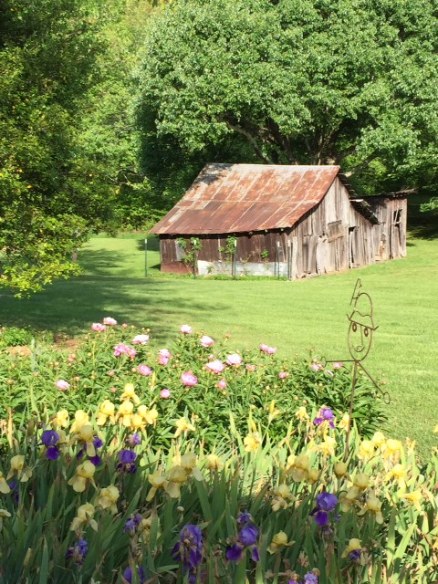
Iris and Peony Bed. The barn in the background dates back more than 100 years serving in a time when most everything eaten year round was raised on the property … plant or animal. The smaller building at the rear was the smoke house where meats were preserved for future use.
We were absolutely astounded with the appearance of the place when we arrived on April 8th. The grass was green and groomed by our landscape helpers Mitch and John. They take care of all of the grass mowing, shrubbery trimming, tree removal/cleanup, pasture bush hog work, burn pile and anything else we ask them to do.
.
.
.
.
.
.
.
.
This short video shows the condition of the garden upon our arrival in late April.

Scattered daffodils are a sure sign that spring is not far away – photos taken Mar 12. This is actually the same bed that contains the Iris and Peonies in the photo above.

Our Peonies originated on the property nearly 100 years ago. We continue to care for them as our ancestors did.
.
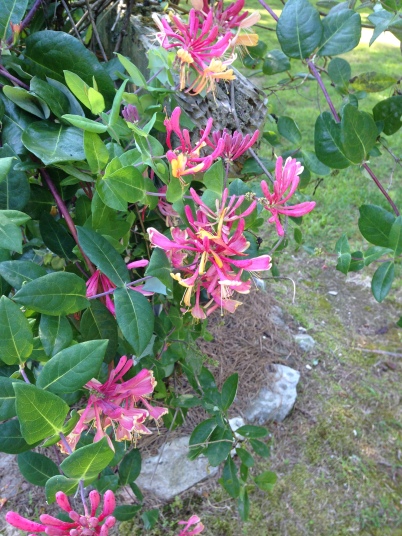
Pink Honeysuckle at the entrance to our mountain property. This vine has been in this place for at least 30 years. It is so well established that it is nearly impossible to kill it … even with total neglect. I am absolutely stunned every year by its beauty. God has created so many unbelievably beautiful flowers!
x
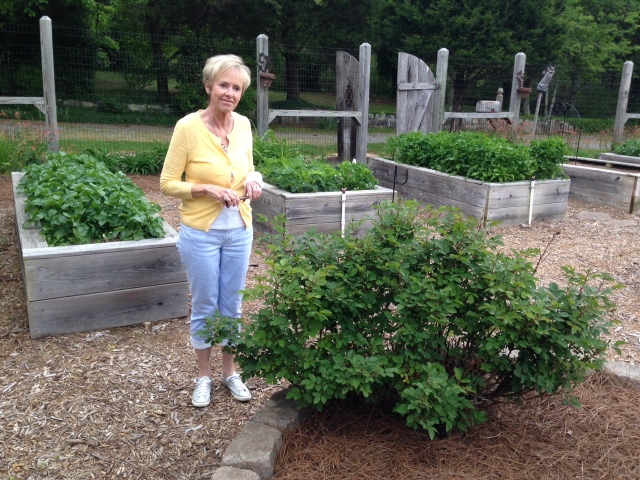
Charlotte admiring one of the white knock-out rose bushes … admiring because a fungus destroyed the red ones and they had to be removed for the protection of other plants. In the background beds (L-R) are Norland Red Potatoes, strawberries and red clover. Photo taken late April, 2015.
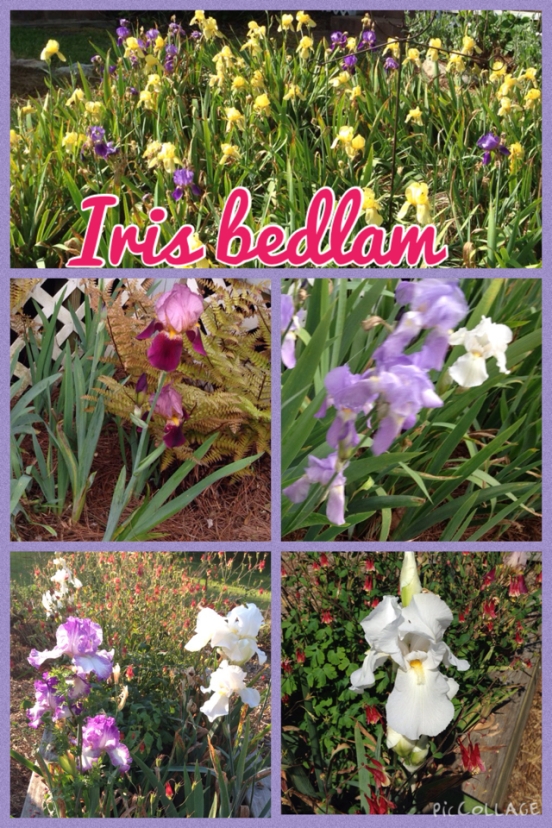
We have Iris in a number of beds around the property. The purple and yellow ones together are among our favorites. The ruffled purple and white are also real beauties.
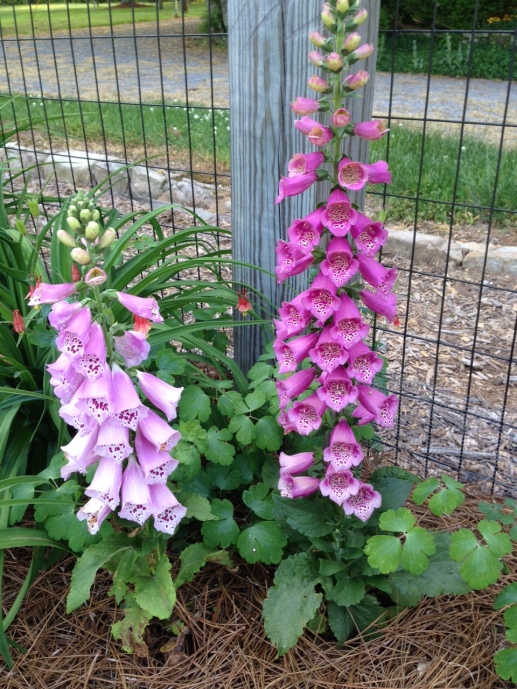
The seeds for these foxglove plants originated from a friend almost 30 years ago. Mrs. Minnie Hembre, deceased some 25 years ago, shared them from her garden. They continue to self-seed and with a little help from us to re-locate them to a suitable spot find a perfect place to prosper.
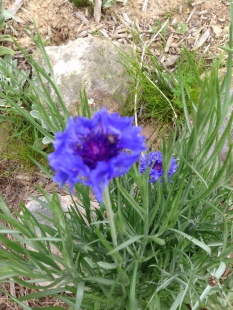
These stunning blue wildflowers located in our rock garden are self seeding. They are early bloomers and will eventually be dwarfed by much taller wildflowers that have a longer growing cycle.
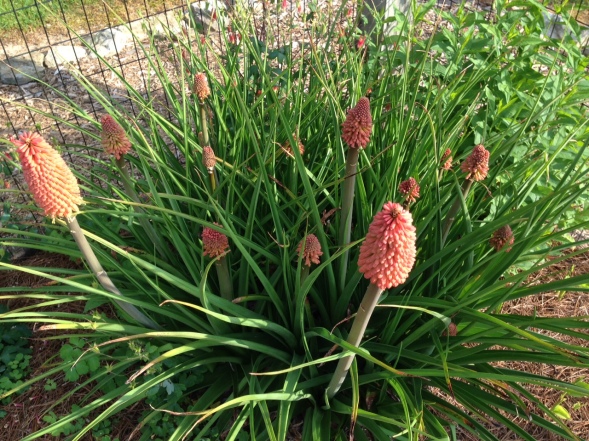
Red Hot Poker (Kniphofia) plants are among the first bloomers. For approximately three weeks in May these beautiful plants put on a real show. Kniphofia (originated in Africa) also called tritoma, torch lily, knofflers or poker plant, is a genus of flowering plants in the family Xanthorrhoeaceae, first described as a genus in 1794. It is native to Africa. Herbaceous species and hybrids have narrow, grass-like leaves 10–100 cm (4–39 in) long, while perennial species have broader, strap-shaped foliage up to 1.5 m (5 ft) long. All plants produce spikes of upright, brightly colored flowers well above the foliage, in shades of red, orange and yellow, often bicoloured. The flowers produce copious nectar while blooming and are attractive to bees. In the New World they may attract sap-suckers such as hummingbirds and New World orioles. The Kniphofia genus is named after Johann Hieronymus Kniphof,[5] an 18th-century German physician and botanist.
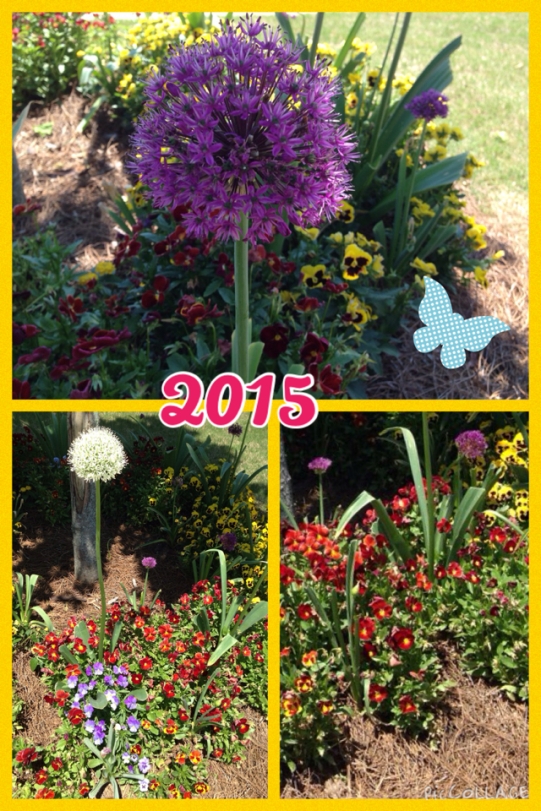
This year Charlotte planted two varieties of Alliums in our small bed at our NE Georgia home. The two varieties were purple (12 inches tall) and white (24-30 inches tall) come from a family of plants that have quite a heritage. Wikipedia says “Many Allium species have been harvested through human history, but only about a dozen are still economically important today as crops or garden vegetables. These include onions (A. cepa), French shallots (A. oschaninii), leeks (A. ampeloprasum), scallions (various Allium species), and herbs such as garlic (A. sativum) and chives (A. schoenoprasum). Others are cultivated as ornamentals.” The onion genus Allium comprises monocotyledonous flowering plants and includes the onion, garlic, chives, scallion, shallot, and the leek as well as hundreds of wild species.
Update 2015-05-25
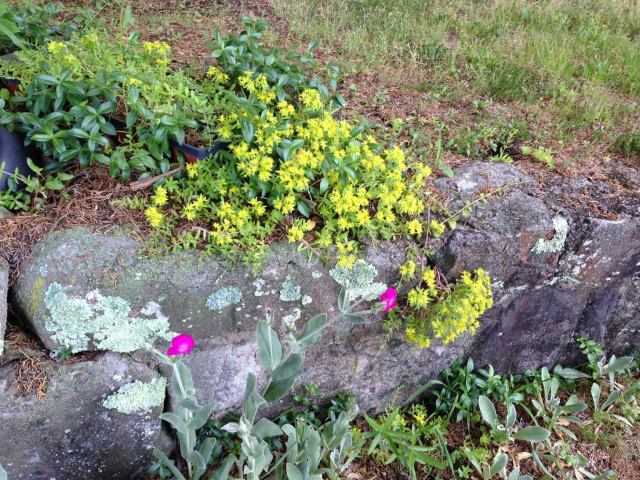
2015 Yellow ground cover growing on rock wall How can you have a bad day when God has provided so much beauty all around us? This low growing ground cover finds a way to bloom … Even when totally neglected. It is a perfect compliment to the rock wall that was built nearly 100 years ago located in front of our raised bed garden.
Update 2015-06-18

Our Rock Garden is located at the rear of our Raised Beds. Several years ago we planted a variety of wildflower seeds. Now the flowers are re-seeding themselves with a different look each month and each year.
Update 2015-06-29
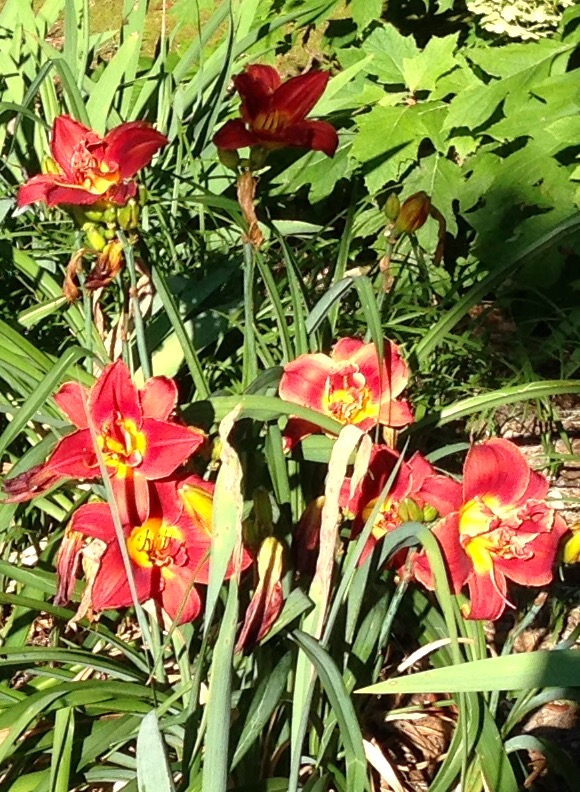
Day Lily growers have produced some stunning varieties. We obtained these beautiful red ones from a farmer one Tuesday at Trade Day in Summerville, Georgia. As with most all varieties, they continue to spread so make plenty of room for them. These grow in a significant amount of shade … receiving sun only in the mid to late afternoon. This photo doesn’t do justice to the deep and rich red color, but the next photo below does.
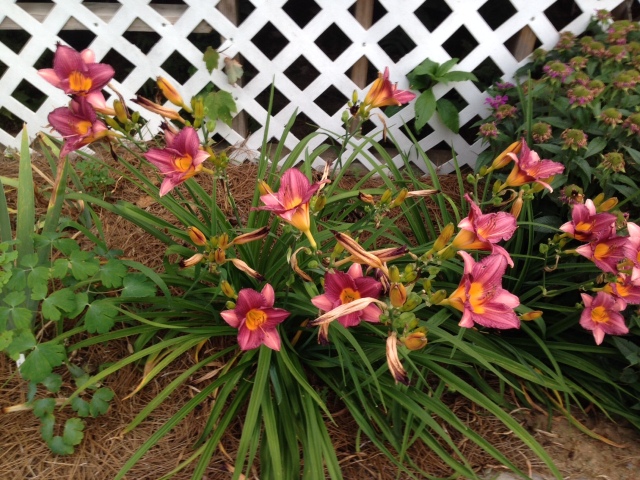
Hemerocallis ‘Stella de Oro’ Day Lillies – This lavender variety is remarkable. Most common of the Stella de Oro variety are the bright yellow ones. This variation blooms about 2 weeks behind the yellow ones in our garden. We are learning how to get multiple blooming cycles … almost continuous … this year by deadheading the spent blooms almost daily and seedpods. The blooms you see here last only one day … ergo ‘day lily’ … but dozens of others are waiting their turn.

The water feature in the round raised bed is complemented by yellow knock out roses, yellow and white calla lilies and annual pink geraniums.
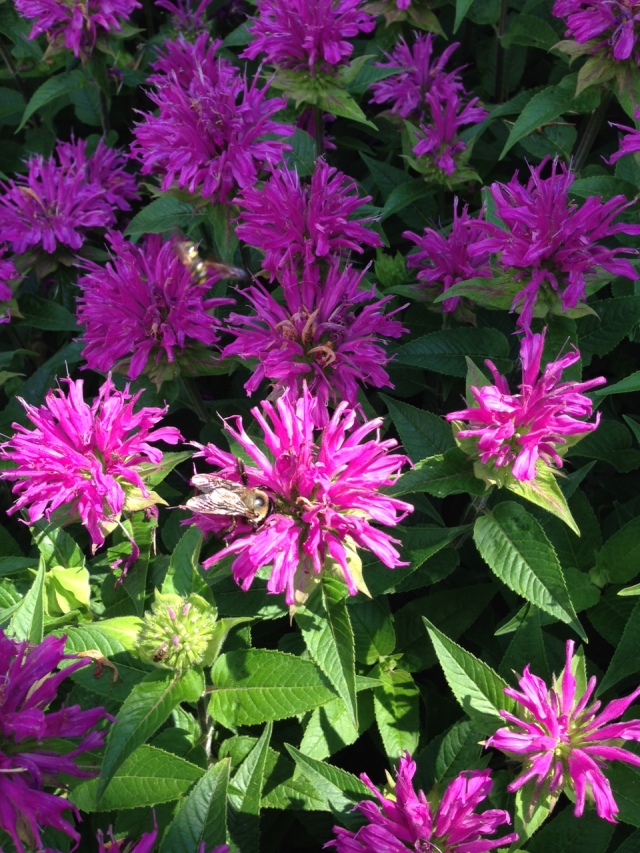
The lavender Bee Balm is one of our favorites. If you look closely you can spot a bumble bee feasting on the bloom.
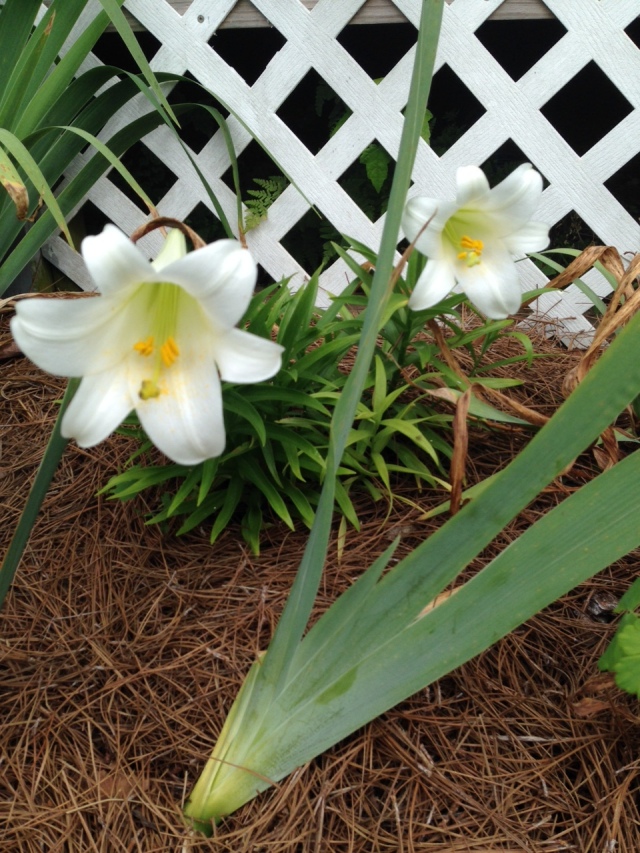
These are “rescued” Easter Lilies … rescued because they were on a throw away rack at Lowes in 2014. The plant had been neglected and were basically dead. We took it to our garden and with a little TLC it was rejuvenated and bloomed in 2015 … one of the earliest bloomers.
2014
INTRODUCTION
Jim’s colon surgery on December 1, 2013 and again on May 1, 2014 affected the start-up of the 2014 flower garden just as it did the vegetables. We had only a brief week in April where the weather was suitable for planting and we used that to the max. But most of the planting had to wait until June when we were able to spend an extended time at the garden.
The cold winter was hard on a number of flowers in the garden. The knock-out roses suffered last year from a fungus. Supposedly the variety had been designed to resist such but we have learned that they were bred in a northern climate absent of the heat and humidity common in the south. After a few years of prospering, the fungus has attacked and destroyed. So Charlotte will be removing most of the knock-outs and replacing them with something more suitable for our climate here on the mountain.
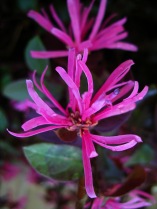 We also lost our compact Crimson Fire Loropetelum shrubs, part of the witch-hazel family native to Japan, China and southeast Asia … just too cold. We will miss the delicate blooms that grace this small shrub in the spring time.
We also lost our compact Crimson Fire Loropetelum shrubs, part of the witch-hazel family native to Japan, China and southeast Asia … just too cold. We will miss the delicate blooms that grace this small shrub in the spring time.
This section of the blog will be regularly updated over the growing season. The updates will be posted most current to oldest. You can view previous year updates by scrolling down to that year.
UPDATES
2015-05-06
Yes, I know … WHY didn’t you post these pics last year?? The answer: I just got too busy with the veggies and neglected this portion of the blog. So here goes with some memories and I will do better for the 2015 season.
xxx
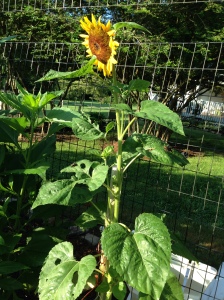
Sunflowers for the birds … they eat the seeds and that helps keep them away from our other favorites.
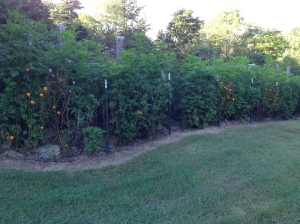
… a mistake of sorts. We planted the backside of our raised bed garden with a large variety and quantity of wildflowers. They were “wild” allright! Many reached 5+ feet tall. The blooms were beautiful but they just took over the space. Back to something more suitable next year.
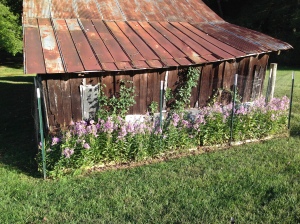
Physostegia (purple) in front of our 120 year old barn that were a gift from our friend Kitty Thomas in Stone Mountain, GA. They have been in our gardens for more than 27 years. Physostegia is a genus of flowering plants in the family Lamiaceae, native to North America. They are erect rhizomatous herbaceous perennials inhabiting damp, sunny places.
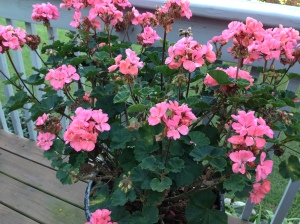
Martha Washington Geranium that Charlotte grows in a pot and carries over from one year to the next by taking it into the garage for the cold season.
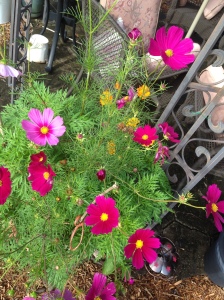
Some of those “wildflowers” growing at the back of our garden that we moved to a pot near the center of our garden so we could enjoy them up close.
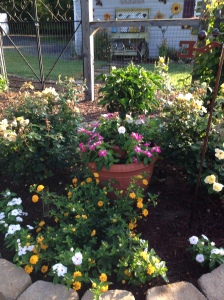
One of the circular raised beds full of white knockout roses, lantana, vinca and a central hibiscus.

Green Limelight Hydrangea – new to the garden last year. Expecting BIG things from this in the future.
.
2014-06-21
 We regularly have fresh-cut flowers in the house and on our deck, patio and front porch.. Charlotte arranged this outstanding display using flowers from our gardens accented by the brilliant color and delicate blooms of the orange Butterfly Weed (Asclepias tuberosa) we obtained from the side of a country road. According to Wikipedia, “It is commonly known as Butterfly Weed because of the butterflies that are attracted to the plant by its color and its copious production of nectar. It is also the larval food plant of the Queen and Monarch butterflies. Hummingbirds, bees and other insects are also attracted.“
We regularly have fresh-cut flowers in the house and on our deck, patio and front porch.. Charlotte arranged this outstanding display using flowers from our gardens accented by the brilliant color and delicate blooms of the orange Butterfly Weed (Asclepias tuberosa) we obtained from the side of a country road. According to Wikipedia, “It is commonly known as Butterfly Weed because of the butterflies that are attracted to the plant by its color and its copious production of nectar. It is also the larval food plant of the Queen and Monarch butterflies. Hummingbirds, bees and other insects are also attracted.“

Some of our friends from Rome, Georgia visit. L-R … Carloyn & Dr. Lamar Barden, Beverly and Jerry Emerson, Charlotte and Jim Davenport
We enjoyed a visit today with our dear friends Dr. Lamar and Carolyn Barden along with Jerry and Beverly Emerson from Rome, Georgia. Jim has served along with Lamar and Jerry as Trustees of Shorter University. We toured our gardens and then had a delightful dinner at the Wildflower Cafe in Mentone. Larry Joe Hall provided music during dinner. As usual, the food was delicious, the service full of hospitality and the atmosphere very enjoyable. L. C. Moon is the owner of the Wildflower and she has done a tremendous job in building a well-recognized business that is a credit to our mountain community. After dinner we returned to our home for some frozen yogurt with pralines and pecans for dessert.
2014-06-20
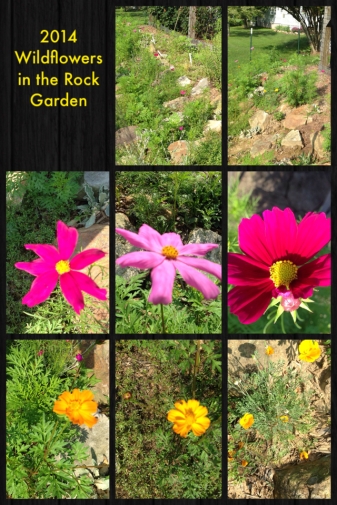 As mentioned in yesterday’s post, for 2014 we added a mixture of wildflowers to the Rock Garden on the back of our Raised Bed Garden. When we purchased the seeds we intended to plant them in one of the corners of our field. However, it would not have been easy for us to enjoy them as the field is not easily visible from our house.
As mentioned in yesterday’s post, for 2014 we added a mixture of wildflowers to the Rock Garden on the back of our Raised Bed Garden. When we purchased the seeds we intended to plant them in one of the corners of our field. However, it would not have been easy for us to enjoy them as the field is not easily visible from our house.
In addition, we usually have the field cut several times a year with a bush hog to keep down the overgrowth. The mixture of colors in the wildflower garden is beautiful as you can see in the picture. We expect the wildflowers to re-seed themselves each year just s the Rose Campion does.
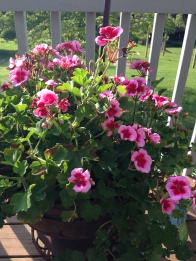
Martha Washington Geranium
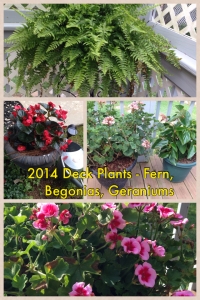 Charlotte has some beautiful flowers in containers on our deck. There are ferns, Portulaca, begonias and geraniums. We keep the begonias and geraniums over from one year to the next by storing them in the garage in front of a sliding glass door. Charlotte’s favorite geranium, the Martha Washington, is shown here. The pictures to show some of the flowers and plants we enjoy every day as we sit on our deck and watch the birds at the feeder and listen to them sing.
Charlotte has some beautiful flowers in containers on our deck. There are ferns, Portulaca, begonias and geraniums. We keep the begonias and geraniums over from one year to the next by storing them in the garage in front of a sliding glass door. Charlotte’s favorite geranium, the Martha Washington, is shown here. The pictures to show some of the flowers and plants we enjoy every day as we sit on our deck and watch the birds at the feeder and listen to them sing.
2014-06-19
 Today it was really hot for the mountain … 91 degrees this afternoon! The early morning was still cool … in the mid 60’s. That is the best time to work in the garden. The next best time is late in the day after the sun scoots behind the trees west of the garden. The ferns and hostas near our deck are at their best this time of year. The orange daylilies that you see growing along the roadsides are blooming at the front of our property. We collected these from the side of our road that winds around to the back of our property. Of course, they have multiplied since we transplanted them and need to be separated.
Today it was really hot for the mountain … 91 degrees this afternoon! The early morning was still cool … in the mid 60’s. That is the best time to work in the garden. The next best time is late in the day after the sun scoots behind the trees west of the garden. The ferns and hostas near our deck are at their best this time of year. The orange daylilies that you see growing along the roadsides are blooming at the front of our property. We collected these from the side of our road that winds around to the back of our property. Of course, they have multiplied since we transplanted them and need to be separated.
Along the back of our raised bed garden we have planted a mixture of wild flower seeds and they have begun to bloom. Lady Bird Johnson would be proud of us. Remember when she established the national program to sew wildflowers along the highways. Once established, they will reseed themselves. There are a number of varieties (to be enumerated later) with flowers that vary from white, yellow, fucia, purple, red and orange. We planted a sampling of the seeds in a planter so that we could identify them at a later date so as not to confuse them with weeds.
Our garden is just full of bees … but unfortunately not the honeybees that we so desire. The picture at the bottom right corner verifies how much the bumble bees love the blanket flowers. They will stay on the bloom for an extended period of time ignoring what is going on around them.
2014-06-16
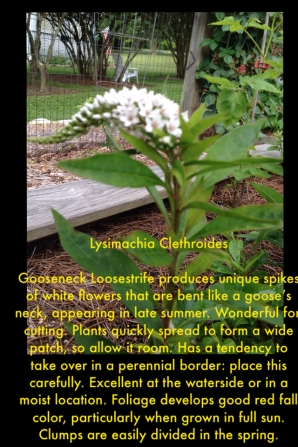 We are cultivating a new perennial this year … Gooseneck Loosestrife (Lysimachia Clethroides). We purchased it last fall at our favorite restaurant, the Canyon Grill. They often sell some of the plants from their flower and herb gardens where they grow a number of unusual plants. Several varieties of our mint also came from their garden. This is a late summer and into the fall bloomer. One of the little plants decided to bloom early. It is shown in the picture to the right. You can readily see why the plant is called “gooseneck.” Since it grows and spreads aggressively taking over an area we plan to locate it in a space somewhat unto itself … like we did our Physostegia which has similar properties.
We are cultivating a new perennial this year … Gooseneck Loosestrife (Lysimachia Clethroides). We purchased it last fall at our favorite restaurant, the Canyon Grill. They often sell some of the plants from their flower and herb gardens where they grow a number of unusual plants. Several varieties of our mint also came from their garden. This is a late summer and into the fall bloomer. One of the little plants decided to bloom early. It is shown in the picture to the right. You can readily see why the plant is called “gooseneck.” Since it grows and spreads aggressively taking over an area we plan to locate it in a space somewhat unto itself … like we did our Physostegia which has similar properties.
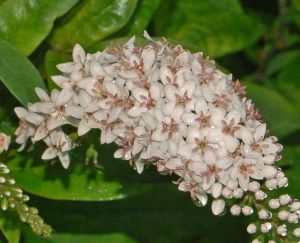 We have a wet spring on our property. Right now it is full because of all of the rain this year. When Jim was a boy this spring was covered by an open-sided covered shelter. Rock walls were built around the spring some time during my great grandfather’s tenure on the property (1885-1941). Earlier this week we planted a Cattail on the edge of the spring hoping that it will stay wet enough to sustain year round growth. We obtained the Cattail from the headwaters of a lake along the roadside on highway 157 on Lookout Mountain near Dougherty Gap. We plan to plant at least one of the Goosenecks on the edge of the spring as they do well in wet areas. The picture of the young gooseneck temporarily growing in our raised bed garden doesn’t do justice to the beautiful blooms. The picture to the right, obtained from Wikipedia, shows the beautiful detail of the delicate little flowers.
We have a wet spring on our property. Right now it is full because of all of the rain this year. When Jim was a boy this spring was covered by an open-sided covered shelter. Rock walls were built around the spring some time during my great grandfather’s tenure on the property (1885-1941). Earlier this week we planted a Cattail on the edge of the spring hoping that it will stay wet enough to sustain year round growth. We obtained the Cattail from the headwaters of a lake along the roadside on highway 157 on Lookout Mountain near Dougherty Gap. We plan to plant at least one of the Goosenecks on the edge of the spring as they do well in wet areas. The picture of the young gooseneck temporarily growing in our raised bed garden doesn’t do justice to the beautiful blooms. The picture to the right, obtained from Wikipedia, shows the beautiful detail of the delicate little flowers.
 Last year we added the perennial Purple Bee Balm to our garden. According to Wikipedia, the official name of the plant is Monarda, “a genus consisting of roughly 16 species of flowering plants in the mint family, Lamiaceae. The genus is endemic to North America. Common names include bee balm, horsemint, oswego tea, and bergamot, the latter inspired by the fragrance of the leaves, which is reminiscent of bergamot orange (Citrus bergamia). The genus was named for the Spanish botanist Nicolás Monardes, who wrote a book in 1574 describing plants of the New World.
Last year we added the perennial Purple Bee Balm to our garden. According to Wikipedia, the official name of the plant is Monarda, “a genus consisting of roughly 16 species of flowering plants in the mint family, Lamiaceae. The genus is endemic to North America. Common names include bee balm, horsemint, oswego tea, and bergamot, the latter inspired by the fragrance of the leaves, which is reminiscent of bergamot orange (Citrus bergamia). The genus was named for the Spanish botanist Nicolás Monardes, who wrote a book in 1574 describing plants of the New World.
Early in the morning and throughout the day, the plant is covered with bumble bees. The blooms are beautiful but they don’t last as long as you would like. When the flowers bloom the plant is covered with pollen. Charlotte got some in her nose and it caused a mild sneezing spell.
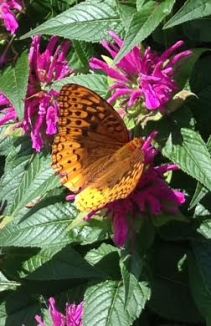
Fritillary Butterfly on Bee Balm – Photo Jim Davenport – Copyright 2014 – Infosys Solutions Associates, Inc.
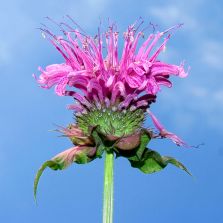
Scientific Classification Kingdom: Plantae
(unranked): Angiosperms
(unranked): Eudicots
(unranked): Asterids
Order: Lamiales
Family: Lamiaceae
Subfamily: Nepetoideae
Tribe: Mentheae
Genus: Monarda
Bee balm also attracts a variety of butterflies. To the left is a nice snap of a Fritillary Jim took a couple of days ago. To the right is a closeup of the bee balm bloom courtesy of Wikipedia … what a beauty!
.
.
To be continued over the 2014 growing season.
2013
Our spring season begins with the emerging of the beautiful double Peonies and the bearded Iris.
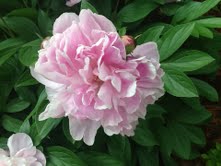
Peony Close-up … these peonies have been in our family for over 100 continuous years! They have a very special place in our garden and in our hearts!!
.
God has provided us a simply beautiful and colorful display. The pansies are a hold-over from winter but everything else can be attributed to spring flowers.
.
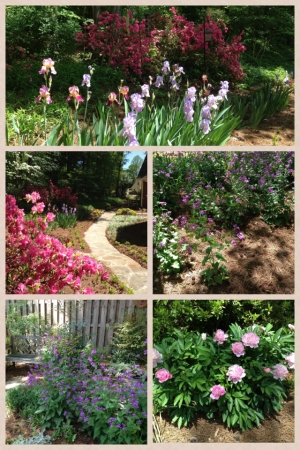
April 24 2014 – Peonies, Iris, Azaleas, Money Plants come alive!! These pictures were taken in our Shade Garden at our home in Snellville, Georgia. We have been developing this garden for twenty-six years and it is really not that difficult to maintain. Each of these plants have special meaning to us.
.
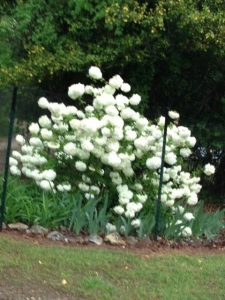
Viburnum – Snowball; blooms in the early spring just after the dogwoods and along with flowers such as iris and peonies.
This viburnum is four to five years old. When it was planted it was a stick. Deer ate the first blooms and even the blooms and the stems the second year. We surrounded the plant with deer netting to protect it and it has flourished. This particular version is referred to colloquially as a snowball bush for obvious reasons. It rivals everything else in our garden for sheer spring beauty. This photo was taken on 2013-04-28.
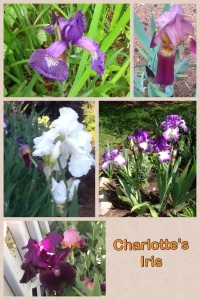
Charlotte has a number of beautiful iris plants that you will not often see. Take a look at these on the right. The white one in the middle on the left side is huge and is astounding when it blooms. The purple and white one on the middle right side has an interesting full flower with wide petals that is a bit different from most. The deep purple one on the bottom is almost black when viewed in lower light.
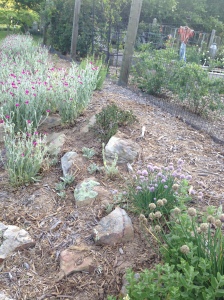
Campion Rose (Lychnis Coronaria) – an old-fashioned plant that will grow just about anywhere. Here they are on the backside of our raised-bed garden.

The striking flower on the right is commonly called a Blanket Plant. This particular variety is a Gillardia Goblin Blanket Plant.
Blanket —> flowers on the right were grown from seed last year and are perennial and come back each year.
There are several varieties of Clematis in the garden. This particular variety (Pink Clematis – Yuzhno-Sakhalinsk) is a real beauty. The petals are soft and most flowers are the size of your hand. The vines will climb up a trellis or even a tree very easily.
.
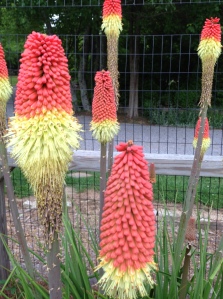
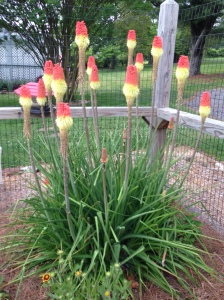 One of the first plants to bloom in our raised bed garden is the Red Hot Poker plant (Kniphofia also called tritoma, torch lily, knofflers or poker plant, is a genus of flowering plants in the family Xanthorrhoeaceae, subfamily Asphodeloideae, that includes 70 or more species native to Africa). The striking blooms do not last long, but when they are blooming they attract hummingbirds and bees. The spikes emerge quickly and flower from the bottom up. The red color is seen first and the yellow works up from the bottom the flower. Eventually the whole flower turns brown. They take up a good bit of space and grow aggressively but when they bloom, they are gorgeous.
One of the first plants to bloom in our raised bed garden is the Red Hot Poker plant (Kniphofia also called tritoma, torch lily, knofflers or poker plant, is a genus of flowering plants in the family Xanthorrhoeaceae, subfamily Asphodeloideae, that includes 70 or more species native to Africa). The striking blooms do not last long, but when they are blooming they attract hummingbirds and bees. The spikes emerge quickly and flower from the bottom up. The red color is seen first and the yellow works up from the bottom the flower. Eventually the whole flower turns brown. They take up a good bit of space and grow aggressively but when they bloom, they are gorgeous.
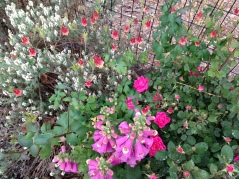
The Columbine and Foxgloves in this photo were grown from seeds given to us by dear friends many years ago. We have been able to keep them going over the years and have saved the seeds. They love their new home in our raised-bed garden. The white blooms in the upper left portion of the photo are from Lavender. And the red/pink buds are Knock-Out roses.
As the early spring season progresses blooms are abundant. The Columbine, Foxgloves, Lavender and Knock-Out Roses soon blossom … then the Hydrangea put on their blooms and gradually take on their beautiful blue, pink and almost purple colors.
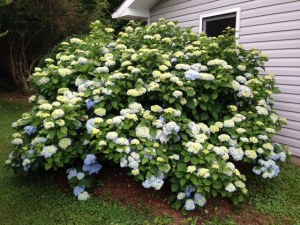
.
I have NEVER seen more blooms on a Hydrangea … When they mature I wonder if you will be able to see the leaves for the blooms??? This mature plant really loves its location. Another picture later??
.
.
.
.
.
.
.
.
This year we added a new flower bed at the back of our deck. This bed is for perennials only and we included Iris, Bee Balm, Blanket and Cone Flowers. The rocks were collected from a location on our property where an old home place for Jim’s paternal Grandmother still stands. The rocks were originally used by Jim’s grandparents to outline a portion of their flower and vegetable garden … long since grown over, but now re-used in accordance with their intended purpose begun in the early 1900’s.
Rose Campion will bloom in full sun or partial shade as is evidenced in the above photo. To the right you can see an Iris bed and four large Hydrangea. There are several more Hydrangea nearby that are not pictured here. The shade in the afternoon provided by a Red Maple towering over the patio makes this a perfect spot for a late lunch or early cook-out.
2012 and Prior Years
 Charlotte spends the majority of her time in our garden with the flowers. It is really cold on Lookout Mountain in the wintertime. The blooms in the winter include camellias, several forms of daffodils, flowering kale and some annual pansies. In the spring the flower garden comes to life with the peonies, multiple kinds of iris, knock out roses, ice plants, foxgloves, clematis, amaryllis, day lilies, calla lilies, ginger lilies, button plants, columbine, oak leaf hydrangea, butterfly bushes, red-hot poker, verbena, hosta, yarrow, trillium, campion rose (lychnis coronaria), gerbera daisies, carpet roses, pineapple sage, thrift, honeysuckle, snowball bush and many other perennials. These are complemented with summer annuals such as sun flowers, marigolds, geraniums (which we winter over), lantana, vinca, hibiscus, portulaca, sultana, zinnia, mandevilla and many others.
Charlotte spends the majority of her time in our garden with the flowers. It is really cold on Lookout Mountain in the wintertime. The blooms in the winter include camellias, several forms of daffodils, flowering kale and some annual pansies. In the spring the flower garden comes to life with the peonies, multiple kinds of iris, knock out roses, ice plants, foxgloves, clematis, amaryllis, day lilies, calla lilies, ginger lilies, button plants, columbine, oak leaf hydrangea, butterfly bushes, red-hot poker, verbena, hosta, yarrow, trillium, campion rose (lychnis coronaria), gerbera daisies, carpet roses, pineapple sage, thrift, honeysuckle, snowball bush and many other perennials. These are complemented with summer annuals such as sun flowers, marigolds, geraniums (which we winter over), lantana, vinca, hibiscus, portulaca, sultana, zinnia, mandevilla and many others.
In the background on the right side you can see the twenty-foot tall pink crepe myrtles in full bloom. The rocks around the perimeter of the garden were gathered from our property.
In the foreground is one of our two round raised beds set aside for summer flowers. In the background is our garden shed. This building was built in the 1930’s and served as a garage for my great-grandfather. We kept the shell of the garage the same as it was before, put a new tin roof and added vinyl siding, new windows and shutters to spruce it up. On the inside we built 24 inch shelves on both sides of the shed to organize our garden supplies and tools. Charlotte had a potting bench constructed to place on the side of the shed. We have an outside sink with running water for potting plants before and pre-washing vegetables before we take them into the house for further processing.
.
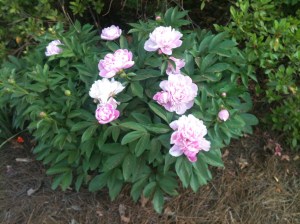
Paeonia (peony or paeony) is a genus of flowering plants, the only genus in the family Paeoniaceae. They are native to Asia, Southern Europe and Western North America.
.
.
.
.
.
.
.
.
.
.
Our peony plants date back to the 1930’s. My great Aunt Bertha Crowe Akins cultivated them in her garden until her death in the late 1970’s. My mother and father then took over the responsibility for maintaining and spreading them to others including my older sister and us. We planted some of them in our Snellville shade garden. They thrive in the full sun but will do well in partial shade as well. This is our favorite flower in our garden.
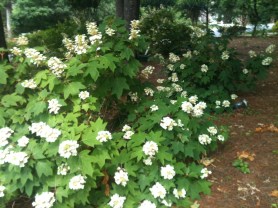
Hydrangea quercifolia, commonly known by its translation oakleaf hydrangea or oak-leaved hydrangea, is a species of flowering plant native to the Southeastern United States, in woodland habitats from North Carolina west to Tennessee, and south to Florida and Louisiana. A deciduous shrub with white showy flower heads, it is a commonly grown garden plant.
.
.
.
These oakleaf hydrangeas are actually part of our Snellville shade garden. They are just too beautiful to leave out since we also have them in our Lookout Mountain garden.
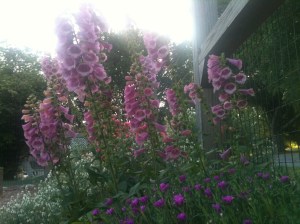
Digitalis purpurea (foxglove, common foxglove, purple foxglove or lady’s glove), is a species of flowering plant in the genus Digitalis, in the family Scrophulariaceae, native and widespread throughout most of temperate Europe. It is also naturalised in parts of North America and some other temperate regions. The plants are well-known as the original source of the heart medicine digoxin, (also called digitalis or digitalin).
.
.
.

Ice Plant – a beautiful and easy to care for perinneal. Give it plenty of room as it will spread voraciously.
.
These purple foxglove plants are a herbaceous biennial … meaning that the plant takes two years to bloom. In the first year the plant forms small green leafs. In the second year the stems shoot up and the flowers form from the bottom of the stem upwards toward the top. After flowering each plant forms thousands of small seeds so tiny (about the size of a mustard seed) that they are difficult to manage. The wind blows them to other parts of the garden where they quietly form their first year plants. The plants are easily moved to a site where you want them to grow. Patience is required for these plants. And by all means, do not eat the any part of this plant including the seeds, flowers or leaves as they are highly toxic to humans and some animals and can even cause death (very unlikely if handled properly). We have been growing them for more than twenty-five years and the bell-shaped flowers are a wonderful addition to our garden.
.
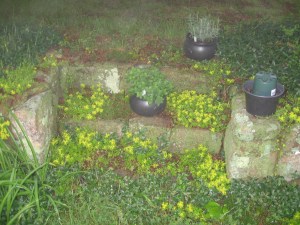
Yellow Flower Moss – early spring-flowering. Works well on rock walls and steps where there is access to the ground. Here the moss is on the steps leading up to the section of the garden where mature dogwoods are abundant.
.
.
.
.
The yellow flower moss and Vinca in this picture provide a wonderful complement to the shady area under some tall cedars planted more than 75 years ago. The yellow flowers don’t last very long, but when they are there they are striking.
.
.
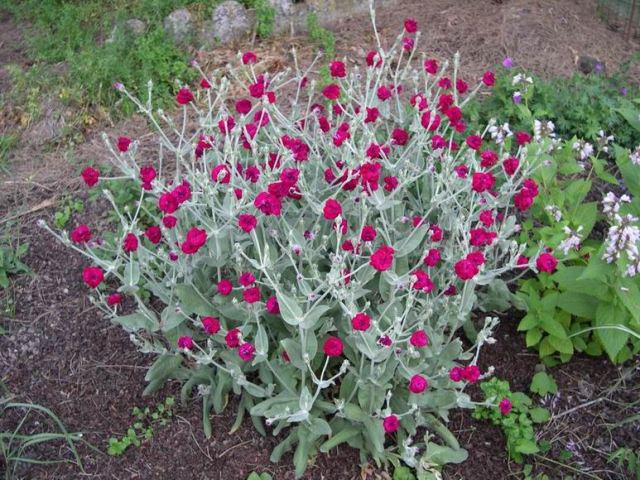
Campion Rose (Lychnis coronaria). They spread easily and are similar in behavoir to foxgloves in that the leafy plant forms in year one and the blooms follow on the stems in year two. Like foxglove, Lychnis spreads seeds by the thousands. We try to keep them on the backside of our garden between the rocks. Each year we have to remove hundreds of small plants to keep them from overrunning anything in their path. These plants don’t require much care at all and bloom profusely for several weeks. They thrive in direct sunshine but will also bloom in partial shade.
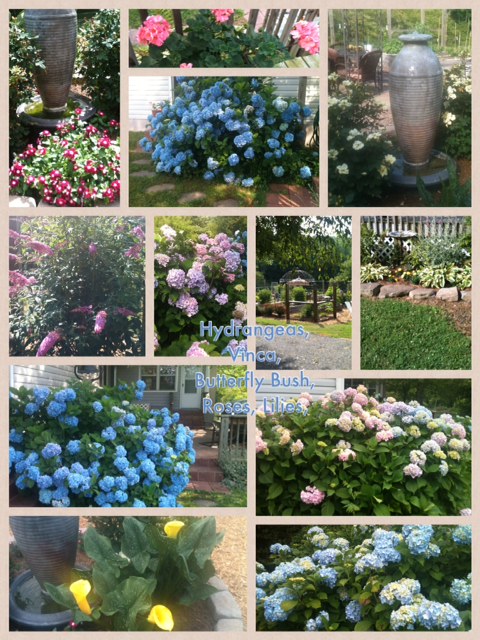
The hydrangea blooms are abundant and take on colors from deep blue to light blue to pink and almost purple. When they bloom, they last for up to a month and really brighten up the landscape.
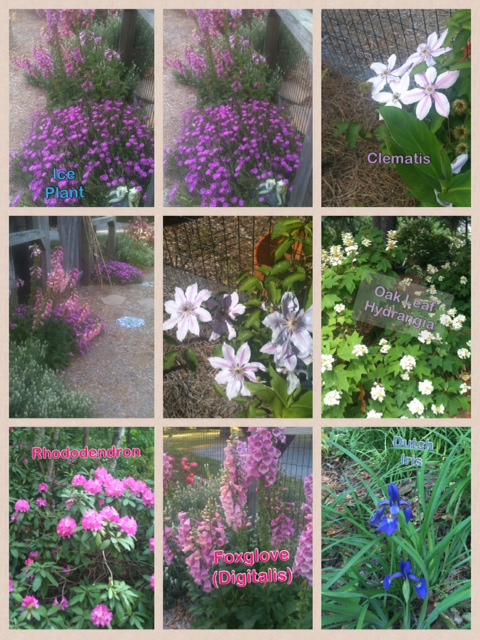
Ice plant, clematis, oakleaf hydrangeas, folgloves … a glorious sight to behold. The rhodedondron is actually in our Snellville shade garden but all of the other plants are located at our Lookout Mountain property.
.
The birds like to land on the top of the fountain and get a cool drink of water. The knock-out roses surround the fountain in a picturesque manner and the rose limbs reach out to the water requiring constant pruning which actually cause them to bloom even more. When the roses first bloom they are yellow in color and as they mature they take on their ultimate white color.
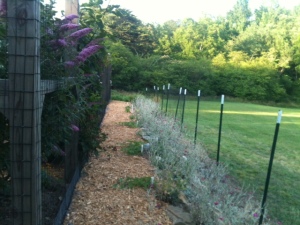
This is the backside of the raised bed garden where we grow herbs and a few melons. The Rose Campion (Lychnis coronaria) is seen on the right. When it is in full bloom, it is a glorious sight.
.
.
.
.
.
.
Here are some collages that were prepared using pictures from our 2012 garden.
.
.
.
.
.
.
.
.
.
.
.
.
.
.
.
.
.
.
.
.
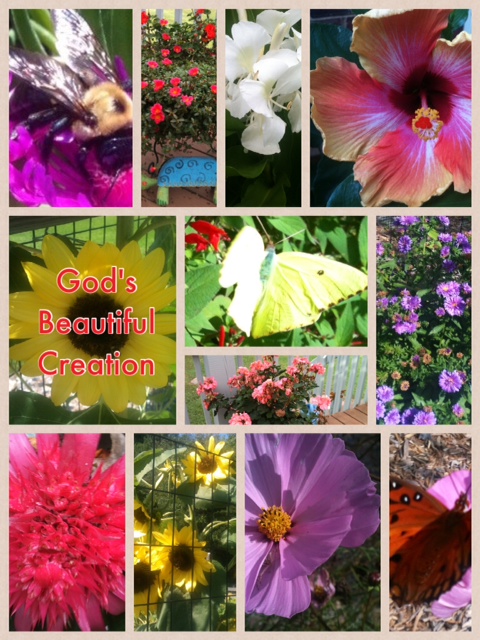
God’s Beautiful Creation – all of these summer flowers give us a great deal of joy and they attract a multitude of butterflies and bees.
.
.
.
.
.
.
.
.
.
.
.
.
.
.
.
.
.
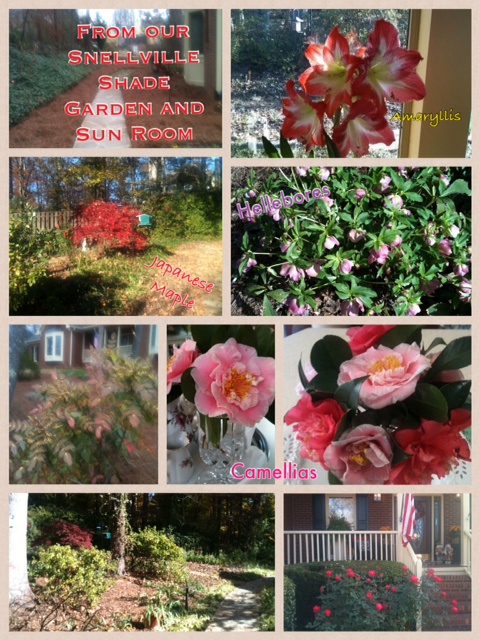
These pictures were taken at our Snellville Shade Garden and Sun Room. Charlotte has something in bloom all year-long. Our table and kitchen most often is graced with wonderful, sweet-smelling blooms throughout the year.
.
.
.
.
.
.
.
.
.
.
.
.
.
.
.
.

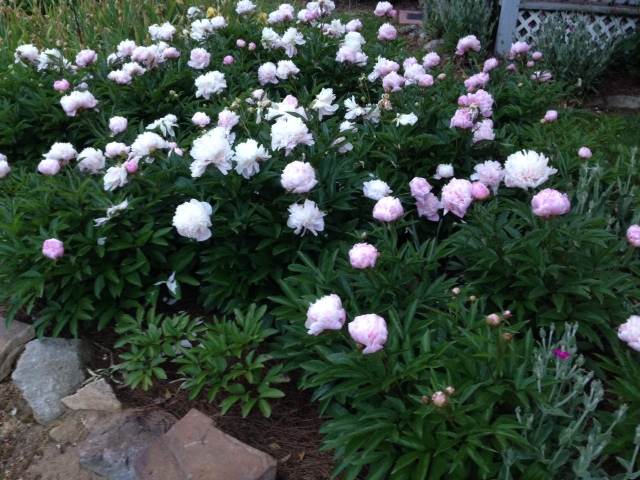
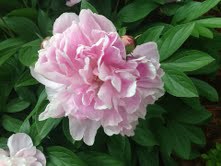
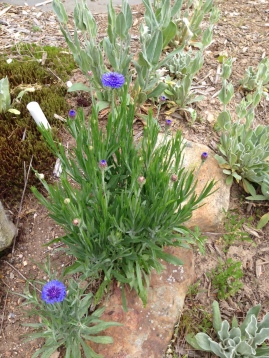
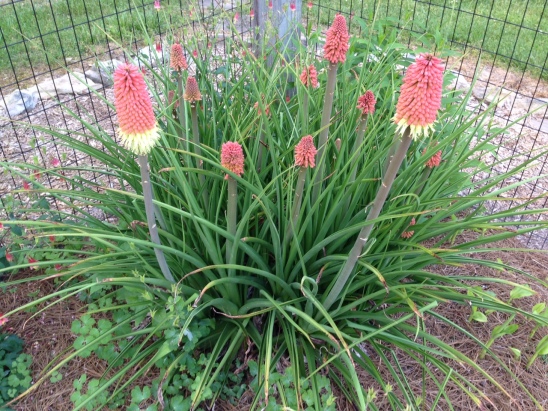
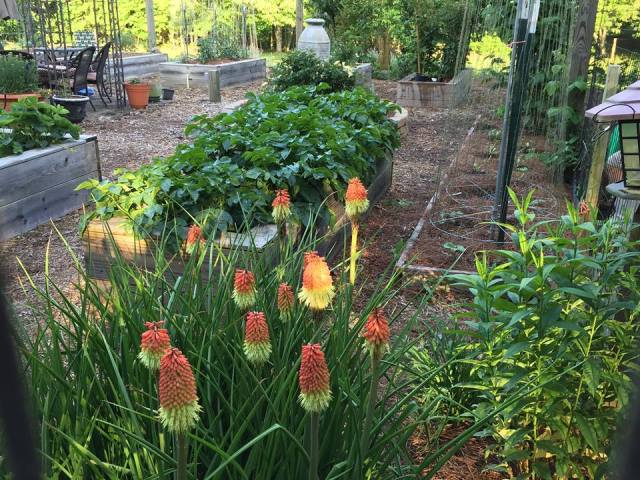
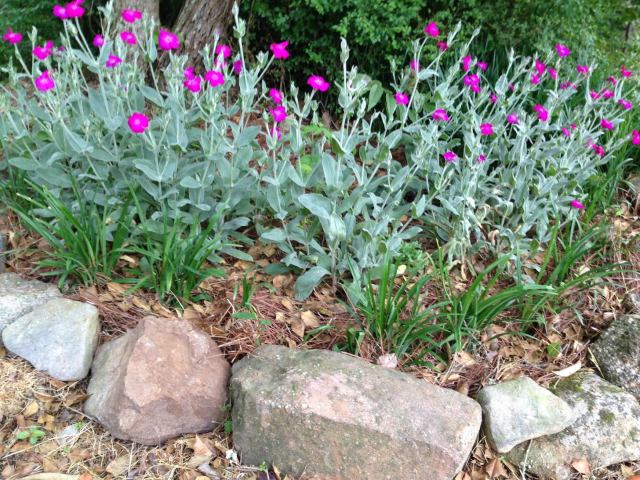

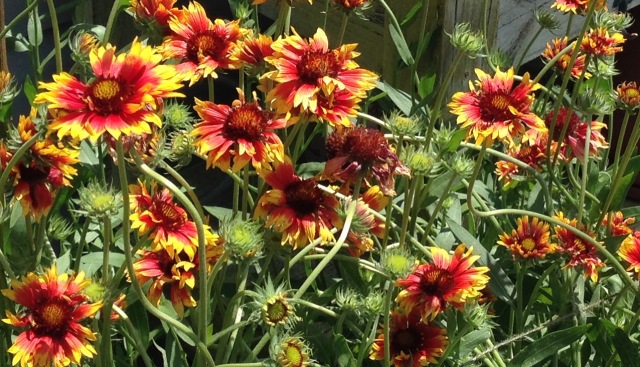

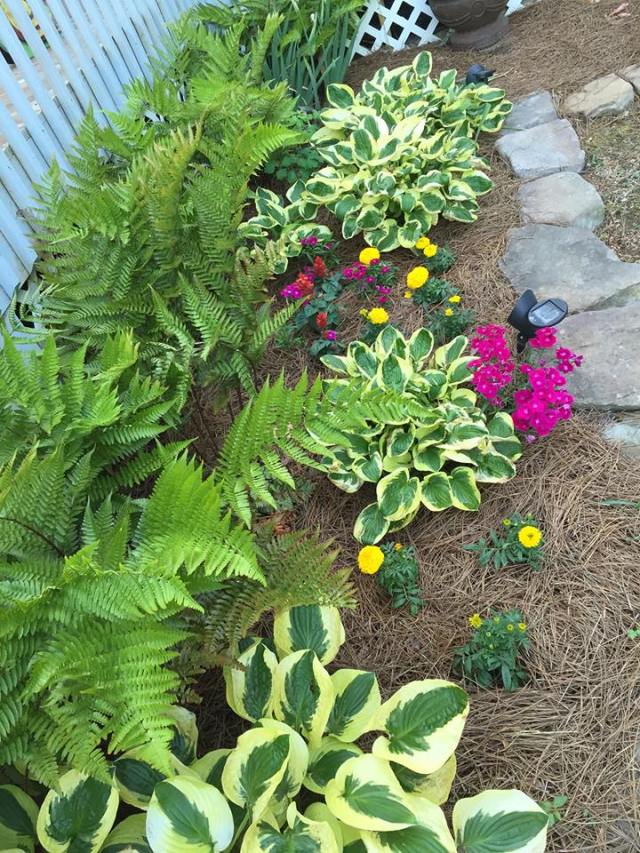


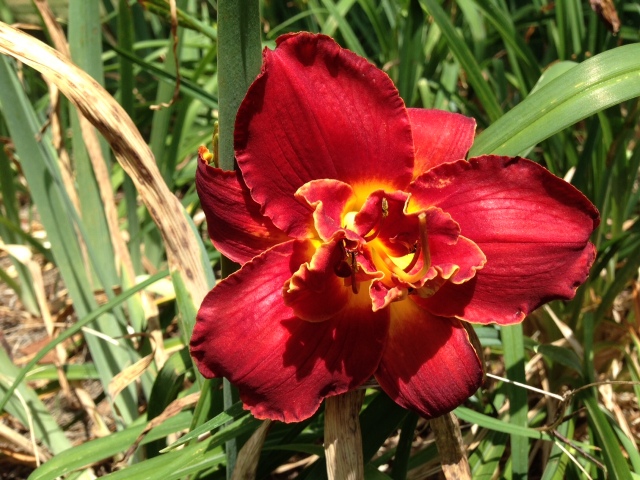

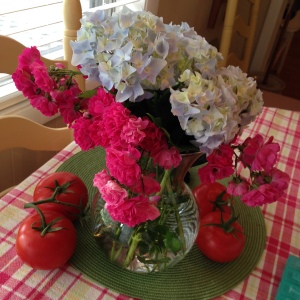

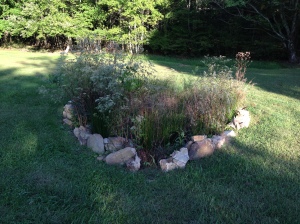

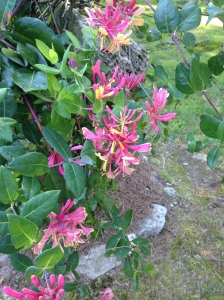
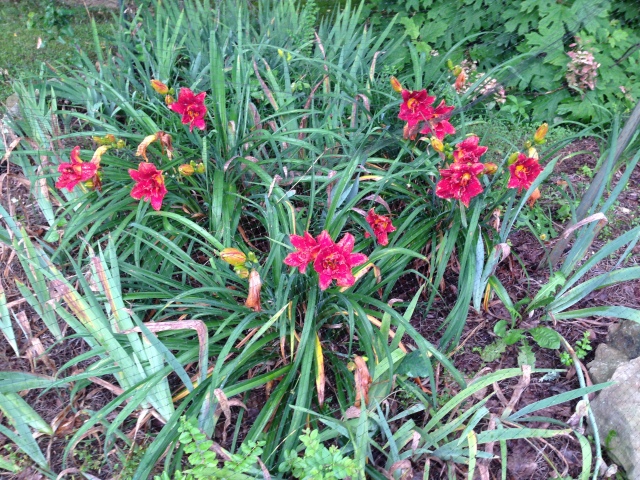
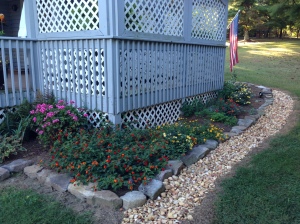
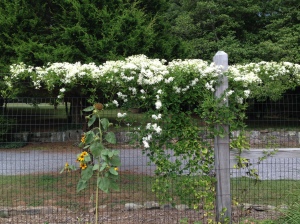
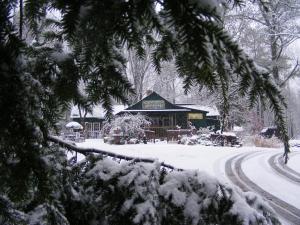
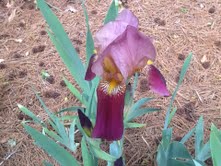
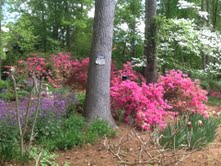
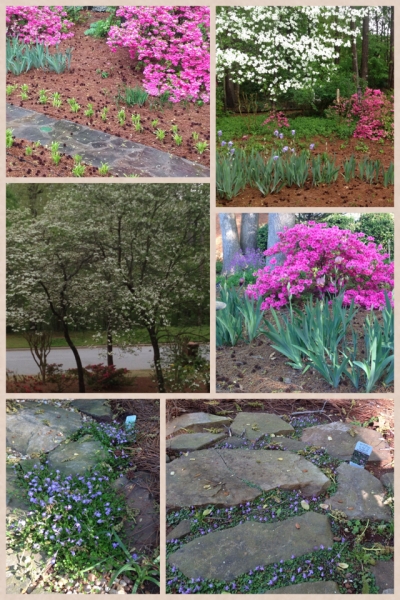
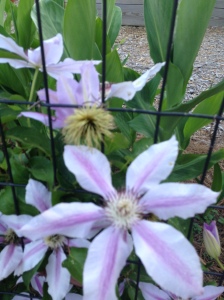
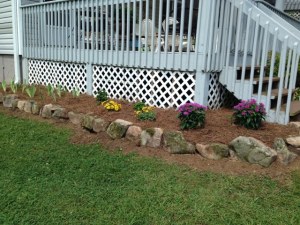
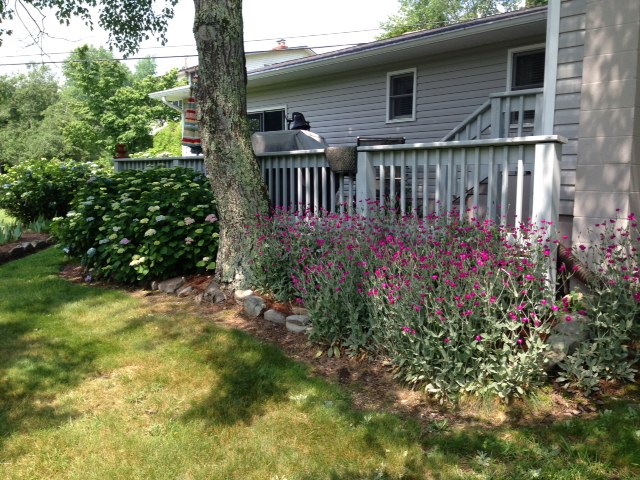

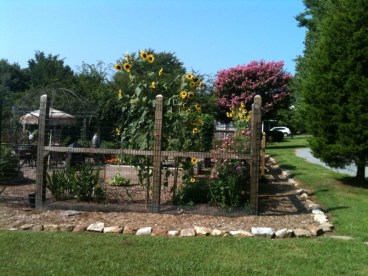
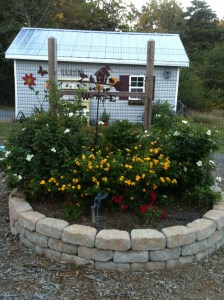
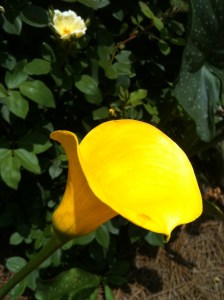

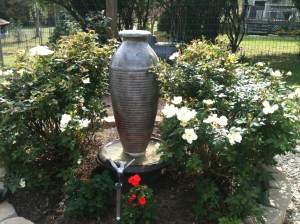
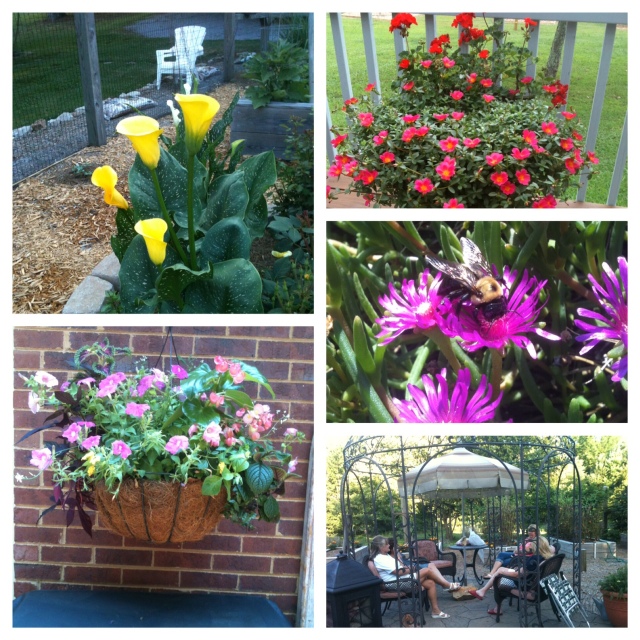








March 26 2013
Jim,
Thanks for sharing. This is awesome. May God continue to Bless You and Charlotte.
John
—————————
March 27 2013
You need to come to Virginia and make that hapen here….what gorgeous flowers.
Ed
Miss you and your lovely wife.
Hope all is well.
LikeLike
Everything is so beautiful!!
LikeLike